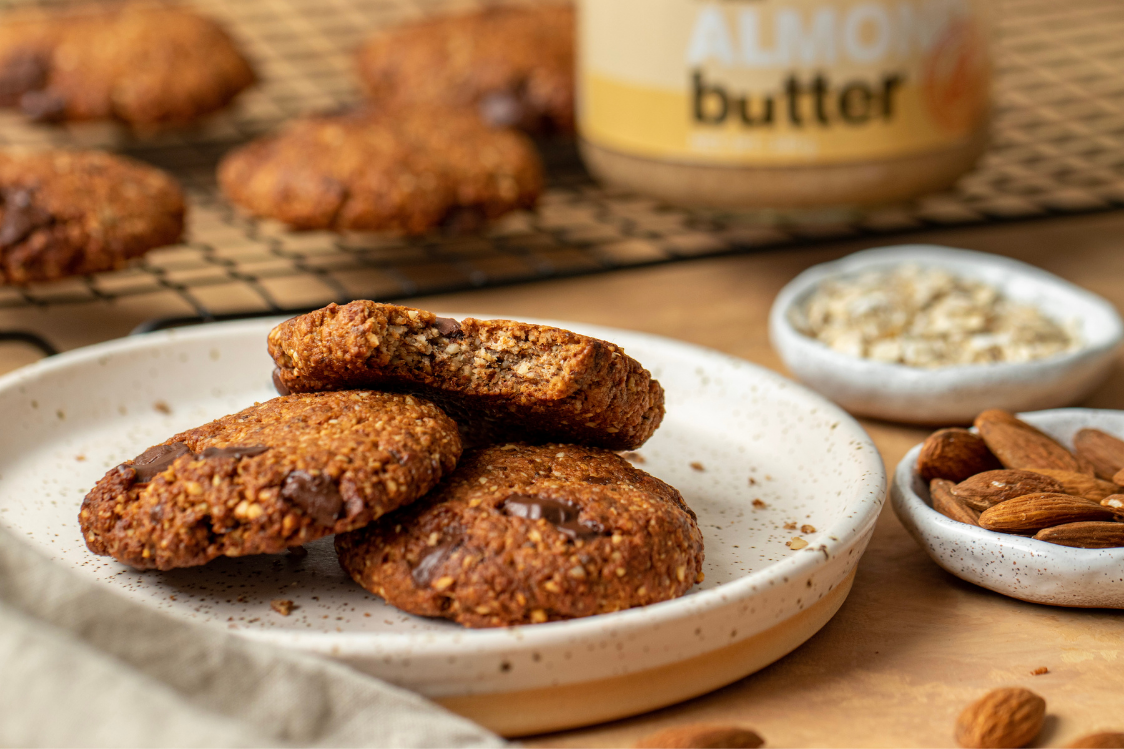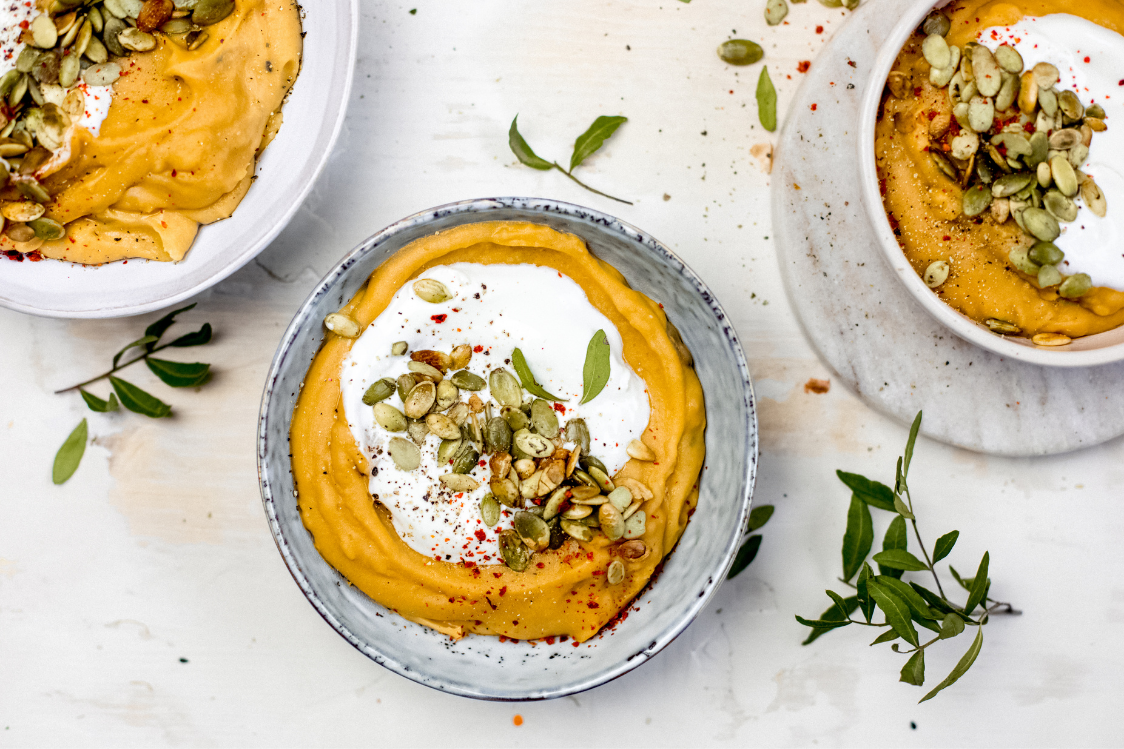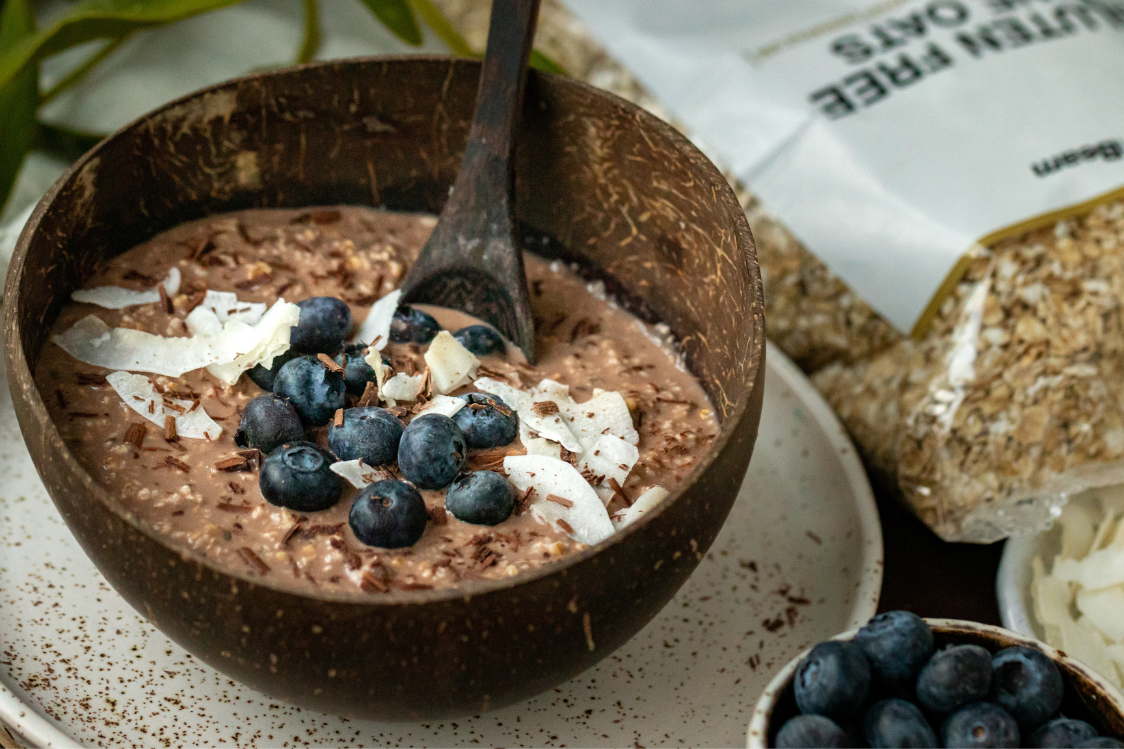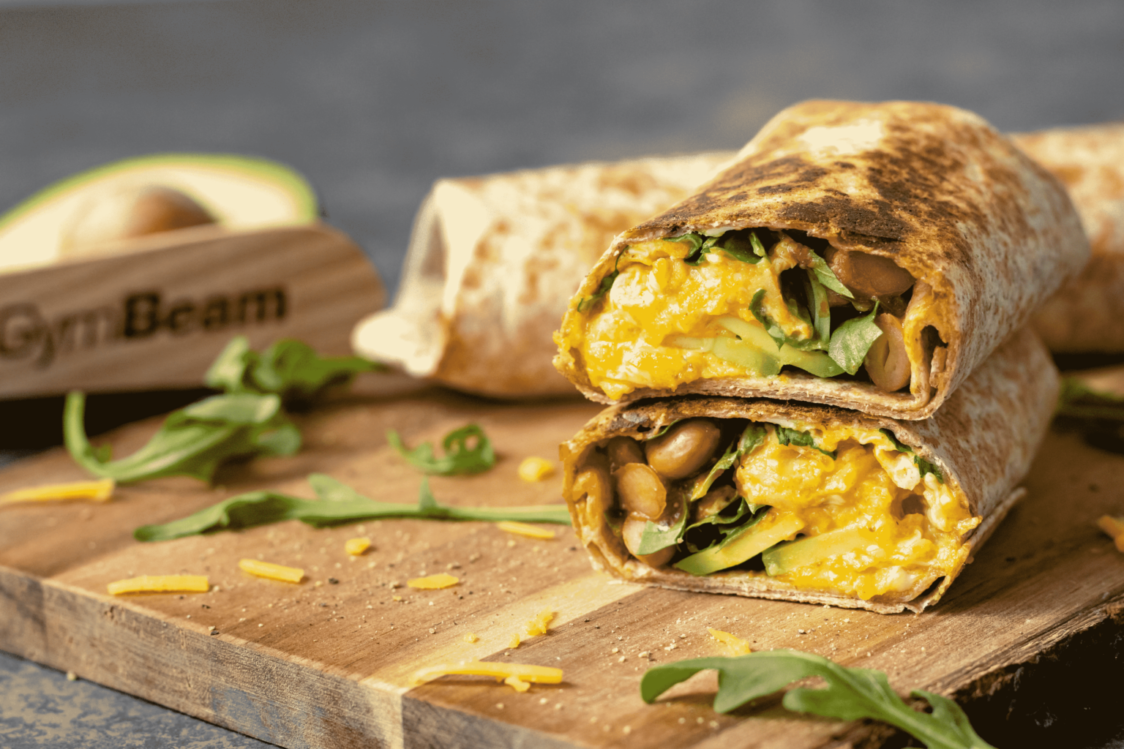Table of Contents
There is probably no doubt that protein is an important part of our diet. However, supplementing it is not always easy. For example, many people still struggle with which sources are the best and where to find protein. That’s why we’ve compiled a list of foods that are literally loaded with protein. Some you may not expect to find among them at all.
Why is protein so important and how much protein do you need?
Protein is one of the three essential macronutrients people need for proper body function. It is not only important for bone health, muscle growth and maintenance, or weight loss. It is also part of enzymes, hormones, genetic structures and defence structures such as white blood cells. Protein is therefore also essential for the immune system. Moreover, it can also help speed up your metabolism and promote regeneration.
According to the general recommendation, protein intake should range from 0.8 – 2 g of protein per kilogram of body weight (BW), depending on age, health status and amount of physical activity. For a 70 kg person, this is 56 -140 g. The upper interval could be followed, for example, by an active strength athlete who is dieting and wants to protect muscle mass from being burned for energy or would like to gain some muscle. The lower limit is more for people who live a sedentary lifestyle.
In order to be able to take in sufficient amounts of protein, you need to have protein-rich foods in your diet regularly. In our article, we will focus on readily available sources of protein that you can easily incorporate into your diet. For each of them, we’ll take a closer look at their approximate nutritional values, their beneficial content and also give you tips for some recipes. [1-3]
The top high-protein foods that can easily be included in your diet
1. Protein powder
It’s probably not surprising that protein powder is at the top of the list. It falls into the category of functional foods that have a beneficial nutritional profile and a positive effect on our health. Thus, you do not have to worry about it containing any dangerous substances. Among the most popular ones are whey protein powders, which are made from pasteurised milk, in which whey is separated from casein thanks to enzymes. It is then further processed to produce a quality protein with an optimal protein content. These make up approximately 70-90%. [4]
For vegans, there are plant-based protein powders, which typically have a less favourable amino acid spectrum. These include, for example, soy, rice, hemp, pea or multi-ingredient plant protein. So it’s up to you which one you reach for.
In addition, some proteins are enriched with other popular ingredients. This then underlines their functionality even more. These may include, for example, various vitamins, minerals, amino acids, digestive enzymes or fat burners. If you want to learn more about proteins, their origins, sources and functions, you should not miss our article How to Choose the Right Protein for Weight Loss or Muscle Growth?
Whey protein powder is so much more than just protein, see how it can improve your life in our article Whey Protein and Its Effect on Muscle Growth, Weight Loss and Health.
Nutritional values of True Whey protein:
Food | Nutritional values | Fats | Fibre | ||
|---|---|---|---|---|---|
| Whey protein True Whey – white chocolate flavour (100g) | 396 kcal | 78.1 g | 7.7 g | 5.9 g | – |
Recipes with protein
Protein doesn’t always have to be consumed in the form of a drink you make in a shaker. Try incorporating it into sweet desserts for example, to enrich them with protein. Be creative and try:

2. Peanuts
If you like to enjoy something good in front of the TV, you will certainly be delighted and pleasantly surprised by peanuts. Peanuts are among the foods with a high proportion of protein and healthy fats. They also boast a considerable amount of beneficial substances and micronutrients, such as magnesium, vitamin B3 (niacin), copper, oleic acid, resveratrol, phenolic acid and flavonoids. Thanks to their unique nutritional profile, peanuts may have an impact on our cardiovascular health, lower cholesterol and reduce the risk of developing type 2 diabetes. You can also reap these benefits with peanut butter. [22-24]
In both cases, however, beware of the high energy content. Similarly, especially with peanut butter, keep an eye on the overall ingredients list so that it contains as little ingredients as possible. For example, a 100% peanut butter that contains only peanuts and nothing else is ideal.
You may also be convinced to eat more peanuts because just one handful (about 28 g) will provide about a quarter of the recommended daily allowance of manganese and about a third of vitamin B9 (folate). A higher intake of folate is particularly important during pregnancy, as it affects the growth of germ tissues. [19] [24]
Want to learn more about peanuts? Then you should not miss our article Peanuts: All You Need to Know About Them.
What are the benefits of peanut butter? Find out in our article Peanut Butter: How to Choose the Highest Quality and What Health Benefits Does It Have?
Nutritional values of peanuts and peanut butter
Food | Nutritional values | Fibre | |||
|---|---|---|---|---|---|
| Peanuts (100 g) | 567 kcal | 26 g | 16 g | 49 g | 9 g |
| Peanut butter (100g) | 596 kcal | 27 g | 14 g | 46 g | 9.1 g |
Recipes with peanuts and peanut butter
- Flapjacks, Muffins, Biscuits, Smoothies and Other Treats
- Curd Bundt Cake with Peanut Butter and Cocoa
- No-Bake Bars Inspired by Legendary Snickers
- Fluffy Protein and Peanut Butter Cake
You might be interested in these products:
3. Chicken meat
Chicken breast is the holy grail of every fitness buff. It is a quality source of protein with minimal fat. In addition, they are carbohydrate-free but boast beneficial substances such as vitamin B3 (niacin), selenium and phosphorus. Their properties make them an ideal food for weight loss, even in the final phase of a pre-race diet. If we are concerned about taste and quality, it is ideal to choose meat from welfare farms. This is because we know the origin and the conditions in which the animal was raised. You may be surprised to learn that the meat of organic or free-range chickens also has slightly more protein (about 2 g). This is mainly because the animal usually lives longer and gets more exercise. [5]
But the breast is not the only part of the chicken that is rich in protein. Thighs or wings are also a great choice. However, these usually already contain more fat, especially because of the skin. If you want to reduce the proportion of this macronutrient, it is ideal to remove it from your meat.
Our tip: If you don’t have time or don’t feel like preparing meat for any other reason, canned chicken breasts can be a great option and can be eaten straight away.
Nutritional values of chicken breast
Food | Nutritional values | Fibre | |||
|---|---|---|---|---|---|
| Chicken breast (100 g) | 110 kcal | 23 g | 0 g | 2 g | 0 g |
Recipes with chicken breast
- Baked Chicken Breasts in Yoghurt Marinade
- Lasagne with Chicken Meat and Ricotta
- Roasted Caprese Chicken
- Aromatic Indian Curry with Shredded Chicken

4. Beef
Beef is a great source of protein, which varies by species in fat content and total energy. If protein is your main priority, it’s ideal to go for a high-quality beef back or sirloin, which are also popular with foodies. The downside, however, is the higher price, which may not be affordable for everyone. Less suitable and fattier are, for example, the leg, belly or flank.
In addition to protein, beef is also a great source of haem iron. This is more easily absorbed than the non-haem iron typically found in plant foods. So if you want to supplement this mineral and you’re not a vegan, beef is a great choice. Iron deficiency could lead to anaemia, which is most often manifested by increased fatigue, poor breathing or pale skin. Women are more susceptible to anaemia as they lose iron from their bodies through menstruation each month. In addition to iron, however, other micronutrients such as vitamin B12 (cobalamin), zinc, selenium and vitamin B3 (niacin) are also found in beef. [6]
Nutritional values of beef tenderloin
Food | Nutritional values | Fats | Fibre | ||
|---|---|---|---|---|---|
| Beef tenderloin (100 g) | 138 kcal | 21 g | 0 g | 6 g | 0 g |
Recipes with beef
- Baked Sweet Potatoes Stuffed with Beef
- Juicy Beef Burrito with Quinoa
- Traditional Mexican Chilli Con Carne with Rice
5. Pork
Even pork is a great source of protein and other micronutrients. These include vitamin B1 (thiamine), selenium, zinc, vitamin B6 (pyridoxine) and B12 (cobalamin). However, the disadvantage is often its higher fat content. With this type of meat in particular, it is also important to look at the quality and ingredients list and ideally choose a leaner cut that is lower in this macronutrient.
For example, pork tenderloin, leg or roast is a great choice. A fattier option is pork neck. Another interesting fact is that a 150g serving of pork tenderloin will provide the entire daily amount of vitamin B3. This is involved in the proper functioning of the psyche and nervous system and also helps to reduce fatigue and exhaustion. [19] [24]
Nutritional values of pork tenderloin
Food | Nutritional values | Fats | Fibre | ||
|---|---|---|---|---|---|
| Pork tenderloin – lean (100 g) | 102 kcal | 21 g | 0 g | 2 g | 0 g |
Recipes with pork
- slices of pork can be grilled, baked, steamed and roasted
- in minced form, it can be used to prepare meat mixes or roasted meatloaf
- tastes great in combination with vegetables, you can bake them together
6. Almonds
Unlike peanuts, almonds truly belong to the nut family. You may never have known that they in fact contain a decent amount of protein. What’s typical about them is their high proportion of healthy fats. However, we shouldn’t overdo it with those either, so it’s ideal to have a handful, for example, rather than the whole packet. In addition, however, they are a source of protein and will also win you over with their high fibre content, which is important for healthy digestion. You may also be surprised to learn that almonds have been associated with fertility since the time of the ancient Romans.
Moreover, nuts are rich in magnesium, potassium, manganese, vitamin E and other micronutrients. Even with almonds, there is no need to consume the nuts alone. You can also enjoy them in the form of a soft butter, which is great in porridges and desserts. And if you’re not a fan of almonds, you can give other nuts a chance too. How about trying pistachios, hazelnuts, walnuts or cashews? You can also enjoy these in the form of delicious creamy butters.
If you want to learn more about almonds, then you should not miss our article Almonds: All You Need to Know About Them.
Nutritional value of almonds
Food | Nutritional values | Fibre | |||
|---|---|---|---|---|---|
| Almonds (100 g) | 575 kcal | 21 g | 22 g | 49 g | 12 g |
Recipes with almonds
- Coconut Protein Balls with Almonds Just Like Raffaello
- Vegan Almond Biscuits with Chocolate Bits
- Christmas Almond Biscuits with Chocolate

7. Lentils
Lentils are a quality and affordable source of protein that is often overlooked. It also contains complex carbohydrates, fibre, and lower amounts of fat. This makes it ideal complex food. You can eat it as a side dish, use it as a base for a meal or liven up a vegetable salad with it. The great advantage is that vegetarians and vegans can enjoy it too. However, it is also rich in micronutrients. It is worth mentioning, for example, its high content of vitamin B9 (folate), B1 (thiamine), copper and iron.
However, there is not just one type. There are several types. You might be familiar with green lentils from the school canteen. Its disadvantage, however, is that it takes longer to cook and has to be soaked in advance. In these respects, it is competing against peeled red lentils, for example, which are ready in no time, are more digestible and do not require soaking. However, you can also find black lentils (beluga), which have a subtle nutty flavour.
And if you haven’t found a taste for lentils yet, you can try lentil chips or pasta for a side dish or salad base. Alternatively, you can also reach for other legumes such as beans, peas, soya or chickpeas. They are a great source of health benefits that support the proper functioning of the body. In general, it’s a great choice to combine legumes with cereals to increase the quality of the protein they contain and bring the amino acid spectrum closer to that of animal protein.
Nutritional value of lentils
Food | Nutritional values | Fats | Fibre | ||
|---|---|---|---|---|---|
| Red lentils (100 g) | 344 kcal | 24 g | 52 g | 2 g | 11 g |
| Green lentils (100 g) | 342 kcal | 25 g | 55 g | 1 g | 6.5 g |
| Black lentils (100 g) | 328 kcal | 24 g | 49 g | 2 g | 9 g |
Lentil recipes
- Light Lentil Salad with Roasted Carrots, Avocado and Feta Cheese
- Creamy Lentil Soup
- Vegan Spaghetti Bolognese

8. Tuna
Tuna is one of the popular marine fish with a high protein content and healthy omega-3 fatty acids. An optimal intake of these fish has been linked, for example, to cardiovascular health. It is also a great source of vitamin B12 (cobalamin) and vitamin D, which in turn is important for bone health and the immune system. You can eat it in the form of a delicious steak or make the preparation easier by using canned tuna in oil or in brine. You can add it to salads or make a delicious spread. [24]
But tuna is not the only delicious fish that is rich in protein, beneficial substances and healthy fats. Salmon, trout, prawns, sardines and other smaller fish species can also be a great choice, as they generally contain far less mercury compared to larger ones such as shark. However, you can also go for seafood.
Nutritional values of tuna
Food | Nutritional values | Fats | Fibre | ||
|---|---|---|---|---|---|
| Tuna steak (100 g) | 137 kcal | 23 g | 0 g | 5 g | 0 g |
| Tinned tuna in oil | 167 kcal | 28 g | 0 g | 6.3 g | 0 g |
| Tinned tuna in own juice | 140 kcal | 24 g | 0 g | 4.9 g | 0 g |
Recipes with tuna
- Poke Bowl with Rice and Tuna
- Tuna Muffins Packed with Protein
- Tuna Spread with Eggs
- Bean Salad with Tuna
- Tuna Wrap with Avocado Dip and Vegetables
9. Pumpkin seeds
Pumpkin seeds are another food that you would expect to be high in fat rather than protein. However, both are correct. They are rich in beneficial omega-3 fatty acids, but also contain manganese, phosphorus and magnesium. This is why they have an effect on the proper functioning of our muscles, nervous system and psyche.
In addition, pumpkin seeds also have a high content of protein and fibre. They are therefore a great food that should definitely not be omitted from your diet. However, pumpkin seeds are not the only seeds with excellent nutritional properties and interesting protein content. Chia or hemp seeds are also a great choice in this respect, especially for smoothies.
Nutritional value of pumpkin seeds
Food | Nutritional values | Fibre | |||
|---|---|---|---|---|---|
| Pumpkin seeds (100 g) | 559 kcal | 30 g | 10.7 g | 49 g | 6 g |
Pumpkin seed recipes

10. Tofu
Tofu is one of the most popular and highest quality sources of plant-based protein. It is made from soybeans and has a high calcium, manganese, copper and selenium content, which has an effect on, for example, the immune function and the maintenance of healthy hair and nails. However, the soya from which tofu is made can also have a good effect on our health. Specifically, it has been linked, for example, to positive effects on the cardiovascular system and a possible reduction in ‘bad’ (LDL) cholesterol levels. [7]
The energy value of tofu can vary considerably depending on the type. If it is in brine, it usually has a higher water content and, conversely, a lower energy value. However, you are more likely to see vacuum-packed tofu without brine, which has a higher energy and protein content. Therefore, the resulting protein and other nutrient content simply depends on the water content and nutritional properties of the soybean. Tofu, however, is not the only popular plant-based protein. Tempeh, which has a slightly nutty flavour, or seitan can also be a great choice. Both of these sources often contain more protein than the popular tofu.
If you want to learn more about plant protein sources, you shouldn’t miss our article Which Plant Protein Sources Are Best and Why Include Them in Your Diet?
Nutritional value of tofu
Food | Nutritional values | Fibre | |||
|---|---|---|---|---|---|
| Tofu in brine (100 g) | 70 kcal | 7.2 g | 0.9 g | 4 g | – |
| Vacuum-packed tofu (100 g) | 157 kcal | 16.1 g | 0.8 g | 9.9 g | – |
Tofu recipes
- Quinoa with Sautéed Tofu, Vegetables and Avocado
- Crispy Tofu Steaks
- Vegan Tofu Stir-Fry with Vegetables
- Chocolate Tofu Pancakes
- Vegan Tofu Scramble
11. Oats
Oats are another food where the protein content may come as a pleasant surprise. They are high in carbohydrates and fibre, but also contain phosphorus, copper, iron, selenium, magnesium and other beneficial micronutrients. However, the composition also includes powerful antioxidants called avenathramides, which help protect cells from oxidative stress. In addition, oats have been linked to a possible effect on lowering blood pressure, the risk of diabetes and cholesterol, thanks to their fibre content in particular. [8-10]
If you regularly have oats on your plate or in your breakfast bowl, you may find other alternatives useful. How about trying buckwheat or millet flakes too? You’ll find that they add a new flavour dimension to your meals.
Nutritional value of oats
Food | Nutritional values | Fats | Fibre | ||
|---|---|---|---|---|---|
| Oats (100 g) | 353 kcal | 14 g | 52 g | 6 g | 15 g |
Recipes with oats
- Overnight Oats with Pudding and Chocolate Crust
- Banana Oat Pancakes
- Fermented Overnight Oats with Nuts and Fruit
- Coconut and Chocolate Overnight Oats

12. Quinoa
Quinoa is a gluten-free pseudo-cereal with a high fibre content. In addition to quality carbohydrates, you will also be pleased to know that it will help with protein replenishment. In addition, it contains attractive amounts of copper and magnesium, which are minerals important for the proper functioning of the body. In addition, it contains many beneficial phenols, terpenoids and flavonoids, which have a number of physiological functions. For example, quercetin, which has antioxidant properties. It helps protect the body against oxidative stress and free radicals. Although its beneficial effects have been talked about especially in recent years, it is certainly not a new food. It has been part of our diet since the pre-Columbian period. The ancient Incas even considered it a gift from God. [11]
Before cooking, it is necessary to bear in mind that quinoa also contains so-called anti-nutrients, which are ingredients that can reduce the absorption of the contained substances. You can reduce the proportion of these undesirable ingredients by rinsing and soaking the quinoa before cooking. If you want to add other pseudo-grains to your diet, then amaranth or buckwheat should not be overlooked. [12]
Interested in learning more about quinoa? Then you should not miss our article Quinoa – a Gluten-Free Cereal and Superfood Rich in Protein, Fibre and Vitamins.
Nutritional value of quinoa
Food | Nutritional values | Fats | Fibre | ||
|---|---|---|---|---|---|
| Uncooked quinoa (100 g) | 352 kcal | 14 g | 57 g | 6 g | 7 g |
Recipes with quinoa
- Salads, Muffins, Mash, Pudding and Other Quinoa Recipes
- Protein Quinoa with Rich Taste of Chocolate and Banana
- Quinoa Stir-Fry with Tofu and Peanuts
- Quinoa with Sautéed Tofu, Vegetables and Avocado
13. Curd cheese
Curd cheese is another must-have in the fridge of all strength-training men and women. It is a universal food that can be eaten in a thousand different ways. The main reason it is so popular in this community is clearly its high content of slowly absorbed casein protein. This is also why, for example, bodybuilders eat it mainly before bedtime. During this time, the body has a longer fasting period, so this food is a great way to provide the body with nutrients during this time. Micellar casein can also be a great alternative to curd cheese.
Depending on your goals and preferences, you can choose how much fat you want in your curd cheese. The great advantage is that it is relatively low in lactose compared to other dairy products and so often does not cause digestive problems even for people with lactose intolerance. In addition, it contains beneficial probiotic cultures and calcium, which is particularly important for healthy bones. Other dairy products that are rich in protein include Skyr or Greek yoghurt with 0% fat.
Nutritional values of curd cheese
Food | Nutritional values | Fats | Fibre | ||
|---|---|---|---|---|---|
| Low fat curd cheese (100 g) | 67 kcal | 12 g | 4 g | 0.5 g | – |
| Light curd cheese (100 g) | 90 kcal | 10 g | 4 g | 3.8 g | – |
| Full fat curd cheese (100 g) | 127 kcal | 9.5 g | 3.5 g | 8.4 g | – |
Recipes with curd cheese
- No-Bake Curd Cheesecake with Raspberries
- Healthy Mole Cake in a Glass
- Flourless Poppy Seed Cake with Curd Cheese Filling
- Savoury Curd Scones with Parmesan Cheese
- Protein Pizza from Curd Dough

14. Spirulina
Spirulina is a popular superfood. It is an extract of freshwater algae, which, thanks to its chlorophyll content, it captivates with its blue-green colour. It will probably also surprise you with its extremely high protein content (57.5 g/100 g). However, it should be noted that the recommended dose is usually up to 10 g. So you can’t count on eating it in larger quantities and using it as a primary source of protein, it serves more as a support for the body’s natural detoxification. It is also often associated with an anti-ageing effect. [25]
Micronutrients such as iron, copper, zeaxanthin or vitamin B2 (riboflavin) are much more valuable. Thanks to phycocyanin, it also acts as a powerful antioxidant. In addition, the results of studies suggest that spirulina may help to reduce bad (LDL) cholesterol levels. In a sufficient dose, it can then help to lower blood pressure. If you’d like to try other superfoods high in protein and other beneficial substances, reach for chlorella or green barley. [13-15]
You can learn more about spirulina and other superfoods in our separate article Superfoods and Their Effects on Health and Immunity.
Nutritional value of spirulina
Food | Nutritional values | Fats | Fibre | ||
|---|---|---|---|---|---|
| Spirulina (100 g) | 290 kcal | 57.5 g | 23.9 g | 7.7 g | 3.6 g |
Recipes with spirulina
- spirulina can be added to water and drunk as a drink
- can also be added to smoothies or oatmeal
- works great in desserts too
- can be taken in tablet form
15. Eggs
Eggs are food that almost everyone has in their fridge. But you may not even realise what a valuable source of nutrients they are. In addition to high quality protein and fat, we can also mention vitamins B2 (riboflavin), B12 (cobalamin) and selenium. In addition, studies have shown that eggs help to increase the value of ‘good’ (HDL) cholesterol.
Egg yolks in particular contain choline, which is used to boost cognitive abilities such as memory and concentration. Eggs also contain lutein and zeaxanthin, which are antioxidants that can promote eye health. The ingredients list of different eggs can vary slightly depending on what the hens have been fed. It is therefore ideal to at the very least avoid cage eggs, where hens generally have poorer living conditions. [16-18]
If you want to use eggs primarily as a source of protein with as little fat as possible, you may find it a great option to straight out buy egg whites. You can use them, for example, in omelettes or breakfast muffins.
Want to discover more about eggs and their benefits? Then you should not miss our article 10 Reasons to Eat Eggs.
Nutritional value of eggs
Food | Nutritional values | Fats | Fibre | ||
|---|---|---|---|---|---|
| Whole eggs (100 g) | 144 kcal | 12.5 g | 1 g | 10 g | 0 g |
| Egg whites (100 ml) | 50 kcal | 10.2 g | 1.1 g | 0.5 g | – |
Recipes with eggs
- Three Egg Recipes for Breakfast
- Stuffed Omelette Wrap
- Cauliflower Rice with Eggs and Vegetables
- Quick Breakfast Burrito with Beans, Avocado and Egg

16. Nutritional yeast
Nutritional yeast is a food popular especially among fans of plant-based diets. It does not contain active yeast, so it is mainly used as a seasoning to add a new flavour dimension to food. It can add a cheesy touch to dishes. Furthermore, it is high in protein and contains vitamins B2 (riboflavin), B3 (niacin), B6 (pyridioxine), B9 (folic acid) and B12 (cobalamin). You will also be pleased to find a high content of antioxidants such as glutathione and selenomethionine.
Nutritional values of nutritional yeast
Food | Nutritional values | Fats | Fibre | ||
|---|---|---|---|---|---|
| Nutritional yeast (100 g) | 327 kcal | 49 g | 9 g | 5 g | 27 g |
Recipes with nutritional yeast
- Pumpkin Gnocchi with Tofu and Spinach
- Lentil Pasta with Creamy Tomato Sauce
- Pasta with Alfredo Cauliflower Sauce
17. Cottage cheese
Thanks to its high protein content and relatively low energy value, cottage cheese is one of the most popular dairy products that definitely makes sense to include in your diet. It also contains a high amount of selenium, vitamin B12 (cobalamin) and calcium, which is important for bone and dental health. However, it also has an effect on the proper function of muscles, digestive enzymes and is important for normal blood clotting. The selenium it contains helps maintain healthy hair and nails. Cottage cheese can usually be found in stores in both sweet and savoury varieties, making it even easier to incorporate into your diet. You can use it as a quick snack with vegetables or fruit or as a base for spreads and summer salads.
Nutritional value of cottage cheese
Food | Nutritional values | Fibre | |||
|---|---|---|---|---|---|
| Cottage cheese (100 g) | 119 kcal | 11 g | 3 g | 7 g | – |
Recipes with cottage cheese
- Breakfast Egg Muffins with Cottage Cheese, Ham and Tomato
- Italian Frittata with Sweet Potatoes
- cottage cheese tastes great in salads or sauces
Bonus tip: Snacks packed with protein
When you don’t have time to prepare your own meals with protein sources, it’s time to reach for ready-made protein treats. Lovers of sweet and savoury snacks will be in for a treat.
Food | Nutritional values | Fibre | |||
|---|---|---|---|---|---|
| MoiMüv Protein Flapjack (90 g) | 356 kcal | 20.1 g | 33.1 g | 14.9 g | 8.8 g |
| MoiMüv Protein Bar (60 g) | 205 kcal | 23 g | 14 g | 6.4 g | 7.4 g |
| BIO Vegan Protein Bar – chocolate and coconut (50 g) | 177 kcal | 10.1 g | 24.2 g | 3.5 g | 2.8 g |
| MoiMüv Protein Cookie – blueberry and white chocolate (75 g) | 302 kcal | 16.5 g | 33.8 g | 10.5 g | 3.4 g |
| Protein chips – sea salt flavour (100 g) | 394 kcal | 21 g | 60 g | 7 g | 6 g |
| Beef Jerky – original (50g) | 155 kcal | 32 g | 0 g | 2.1 g | – |
For more tips on protein-packed snacks, see our article How to Sneak More Protein Into Your Diet?

What should you remember?
As you can see, adding protein to your diet doesn’t have to be hard. It’s easy to do so with foods that are available practically everywhere, or you may even have them already in your pantry, freezer or fridge. And we haven’t even listed them all. Fortunately, there are many different sources, so even vegetarians or vegans don’t have to worry about protein deficiency.
Do you have someone amongst your friends who have trouble eating enough protein? Share our article with them. Maybe you can broaden their horizons about foods that contain this macronutrient.
[1] Bernaciková, M., Masarykova univerzita, & Fakulta sportovních studií. – Regenerace a výživa ve sportu
[2] Ralf Jäger et al. – International Society of Sports Nutrition Position Stand: protein and exercise – https://jissn.biomedcentral.com/articles/10.1186/s12970-017-0177-8
[3] Thermic Effect of Food – https://examine.com/topics/thermic-effect-of-food/
[4] SeemaPatel – Functional food relevance of whey protein: A review of recent findings and scopes ahead – https://www.sciencedirect.com/science/article/pii/S1756464615004570
[5] Débora Cristina Fernandes da Silva et al. – Quality characteristics of broiler chicken meat from free-range and industrial poultry system for the consumers – https://www.ncbi.nlm.nih.gov/pmc/articles/PMC5495705/#CR8
[6] The Vegan Society. Iron – https://www.vegansociety.com/resources/nutrition-and-health/nutrients/iron
[7] D. Dan Ramdath et al. – Beyond the Cholesterol-Lowering Effect of Soy Protein: A Review of the Effects of Dietary Soy and Its Constituents on Risk Factors for Cardiovascular Disease – https://www.ncbi.nlm.nih.gov/pmc/articles/PMC5409663/
[8] Joseph M Keenan, Joel J Pins et al. – Oat ingestion reduces systolic and diastolic blood pressure in patients with mild or borderline hypertension: a pilot trial – https://pubmed.ncbi.nlm.nih.gov/11978262/
[9] Eva Qing Ye et al. – Greater whole-grain intake is associated with lower risk of type 2 diabetes, cardiovascular disease, and weight gain – https://pubmed.ncbi.nlm.nih.gov/22649266/
[10] J T Braaten et al. – Oat beta-glucan reduces blood cholesterol concentration in hypercholesterolemic subjects – https://pubmed.ncbi.nlm.nih.gov/7956987/
[11] Minyi Lin et al. – Quinoa Secondary Metabolites and Their Biological Activities or Functions – https://www.ncbi.nlm.nih.gov/pmc/articles/PMC6651730/
[12] Elena Peñas Pozo et al. – Functional Components and Anti-Nutritional Factors in Gluten-Free Grains: A Focus on Quinoa Seeds – https://www.ncbi.nlm.nih.gov/pmc/articles/PMC7915320/
[13] Spirulina – https://examine.com/supplements/spirulina/
[14] Elias E Mazokopakis et al. – The hypolipidaemic effects of Spirulina (Arthrospira platensis) supplementation in a Cretan population: a prospective study – https://pubmed.ncbi.nlm.nih.gov/23754631/
[15] Patricia V Torres-Duran et al. – Antihyperlipemic and antihypertensive effects of Spirulina maxima in an open sample of mexican population: a preliminary report – https://www.ncbi.nlm.nih.gov/pmc/articles/PMC2211748/
[16] P Schnohr et al. – Egg consumption and high-density-lipoprotein cholesterol – https://pubmed.ncbi.nlm.nih.gov/8120521/
[17] Lutein – https://examine.com/supplements/lutein/
[18] G J Handelman et al. – Lutein and zeaxanthin concentrations in plasma after dietary supplementation with egg yolk – https://pubmed.ncbi.nlm.nih.gov/10426702/
[19] FoodData Central – https://nutritiondata.self.com/
[20] Databáze složení potravin – https://www.nutridatabaze.cz
[21] FoodData Central – https://fdc.nal.usda.gov/fdc-app.html#/
[22] Michelle Wien et al. – A randomized controlled trial to evaluate the effect of incorporating peanuts into an American Diabetes Association meal plan on the nutrient profile of the total diet and cardiometabolic parameters of adults with type 2 diabetes – https://www.ncbi.nlm.nih.gov/pmc/articles/PMC3902416/
[23] What are the nutritional benefits of peanuts? – https://www.medicalnewstoday.com/articles/325003#nutrition
[24] Commission Regulation (EU) No 432/2012 of 16 May 2012 establishing a list of permitted health claims made on foods, other than those referring to the reduction of disease risk and to children’s development and health – http://data.europa.eu/eli/reg/2012/432/oj
[25] Spirulina – https://examine.com/supplements/spirulina/


Add a comment